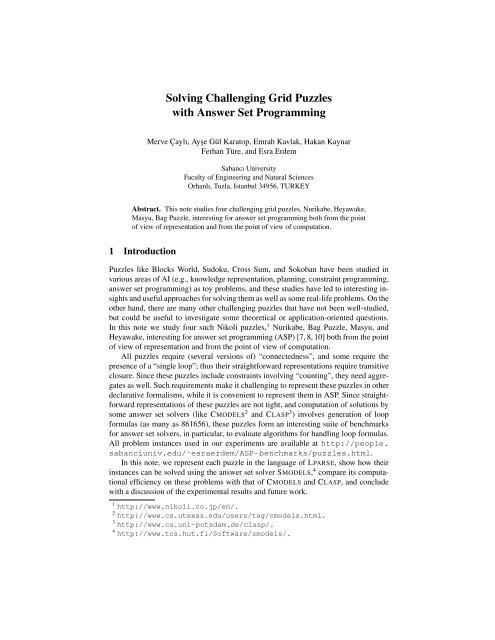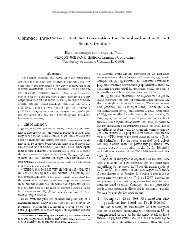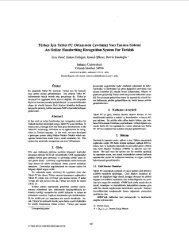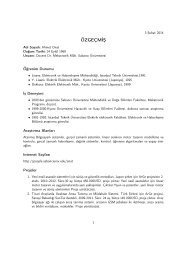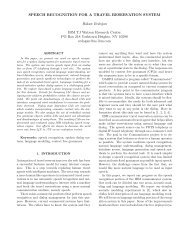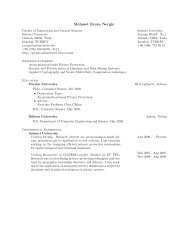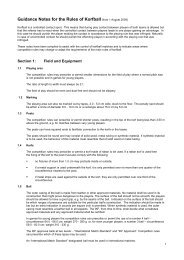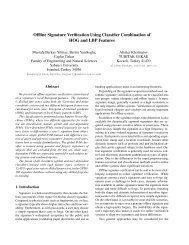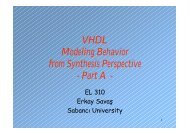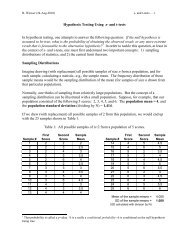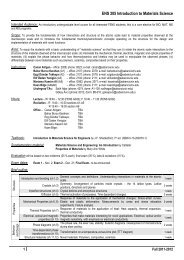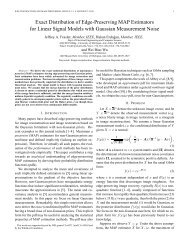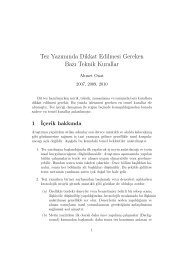Solving Challenging Grid Puzzles with Answer Set Programming
Solving Challenging Grid Puzzles with Answer Set Programming
Solving Challenging Grid Puzzles with Answer Set Programming
Create successful ePaper yourself
Turn your PDF publications into a flip-book with our unique Google optimized e-Paper software.
Fig. 5. A sample Heyawake puzzle and its solution.room(0,1,1,2,2).room(1,1,3,2,5).room(2,6,1,8,2).room(3,3,4,5,5).room(4,3,1,5,2).room(5,3,3,5,3).room(6,6,3,8,5).room(7,3,6,5,8).room(8,6,6,8,7).room(9,1,6,2,8).room(10,6,8,8,8).room(13,9,6,10,8).room(11,9,1,10,2).room(12,9,3,10,5).room(14,9,9,10,10).room(17,1,9,2,10).room(16,3,9,5,10).room(15,6,9,8,10).has(0,0).has(1,1).has(2,1).has(3,2).has(4,-1).has(5,-1).has(6,2).has(7,5).has(8,0).has(9,-1).has(10,-1).has(11,-1).has(12,-1).has(13,1).has(14,0).has(15,-1).has(16,-1).has(17,-1).Fig. 6. The input file describing the Heyawake puzzle in Fig. 5.remaining conditions H1, H2, H5 are ensured by some constraints that require auxiliarydefinitions. For instance, to ensure that a straight path connecting two white cells doesnot pass through three or more rooms, we introduce the definition of a horizontal orvertical straight path of white cells passing through 3 rooms (by path).4 MasyuMasyu (also called Pearl Puzzle) is played on a rectangular grid. Initially some gridcells contain circles; each circle is either white or black, like in Fig. 9. The goal isto draw a single, continuous line that properly passes through all circled cells, like inFig. 9, according to the rules below:M1 The line should form a single loop.M2 White circles must be traveled straight through, but the loop must turn (90 degrees)in the previous and/or next cell in its path;M3 The loop must turn (90 degrees) at black circles, but it must travel straight throughthe next and previous cells in its path.Deciding whether there is a solution to Masyu is NP-complete [4].We describe Masyu in the language of LPARSE as follows.
% File: heyawake.lpcol(1..m). row(1..n). num(0..r-1). segment(h;v).room_size(N,X1,Y1,X2,Y2) :- room(A,X1,Y1,X2,Y2), has(A,N).% H3: In each room containing a cell numbered N (N>0),% paint N cells blackN {black(C,R):col(C):row(R):C1
% H5: A straight path connecting two white cells (C,R) and (X,Y)% does not pass through three or more rooms.:- path(S,C,R,X,Y,3), white(C,R), white(X,Y), col(C;X), row(R;Y),segment(S).% horizontal (h) and vertical (v) straight paths of white cells% whose lengths are at most 3path(S,C,R,C,R,1) :- white(C,R), col(C), row(R), segment(S).path(h,C,R,C1,R,N) :- path(h,C+1,R,C1,R,N), adj(C,R,C+1,R),white(C,R), inroom(C,R,A), inroom(C+1,R,A),col(C;C1), row(R), num(N),N
Fig. 9. A Masyu puzzle and its solution.white(1,3). black(1,6). black(3,1). black(3,4). white(3,5).black(3,8). white(3,10). white(4,7). black(5,3). black(5,8).white(5,9). white(5,10). white(6,6). white(7,2). white(7,4).white(7,7). white(7,8). white(8,2). white(8,5). black(9,9).black(10,1). white(10,3). white(10,6).Fig. 10. The input file describing the Masyu puzzle in Fig. 9.are introduced: visible and out. The former describes the visibility of a cell fromanother one, and the latter checks whether a cell is outside the loop or not.We describe Bag Puzzle in the language of LPARSE as follows.Input and Output Suppose that we are given a Bag puzzle <strong>with</strong> a rectangular grid ofsize n × m, containing some numbered cells. Each grid cell is identified by its lowerleft grid point; so a cell (X,Y) containing a number N is described by an atom of theform cell(N,X,Y). For instance, the input file describing the Bag puzzle in Fig. 13is presented in Fig. 14. Solutions to Bag puzzles can be characterized by atoms of theform line(S,X,Y) (“if S=h (resp. S=v then the horizontal (resp. vertical) segment((X,Y),(X+1,Y)) (resp. ((X,Y),(X,Y+1))) is contained in the drawn line”).6 DiscussionWith the programs discussed above, we have experimented <strong>with</strong> some instances ofthe grid puzzles (Nurikabe, Heyawake, Masyu, Bag Puzzle) using SMODELS (Version2.32), CLASP (Version 1.0.2), and CMODELS (Version 3.55) <strong>with</strong> ZCHAFF (Version2007.3.12). All problem instances are available at http://people.sabanciuniv.edu/˜esraerdem/ASP-benchmarks/puzzles.html. The experimental resultsare summarized in Tables 1 and 2. All CPU times are in seconds, for a workstation<strong>with</strong> a 1.5GHz Xeon processor and 4x512MB RAM, running Red Hat Enterprise Linux(Version 4.3). The computation times include the time spent for grounding; only thecomputation times less than 400 seconds are shown.
% File: masyu.lpcol(1..n). row(1..m). direction(v;h).ball(X,Y) :- black(X,Y), col(X), row(Y).ball(X,Y) :- white(X,Y), col(X), row(Y).% Generate a set of unit segments passing through cells{line(S,X,Y)} :- direction(S), col(X), row(Y).:- line(h,n,Y), row(Y).:- line(v,X,m), col(X).% including balls::- ball(X,Y), not on(X,Y).on(X,Y) :- line(S,X,Y), direction(S), col(X), row(Y).on(X+1,Y) :- line(h,X,Y), col(X), row(Y), X
Table 1. Experimental results: Problem sizePuzzle Instance <strong>Grid</strong> SMODELS CMODELS CLASPsize # of # of # of # of # of loop # of loop averageatoms rules atoms clauses formulas formulas loop sizeNurikabe n1 10 × 10 20661 84410 63319 191567 35417 16.7n2 20667 84668 74642 235436 50736 17.1n3 20667 84671 62806 192199 8210 16450 12.4n4 20667 84669 75063 236212 26564 15.3n5 20673 84930 68775 208882 6320 11573 12.8n6 20664 84539 78402 247622 19052 14.2n7 20670 84803 66592 203623 4744 15793 13.3n8 15 × 15 102657 436972 438712 1414579 388361 20.7n9 102710 437248 426668 1365831n10 102660 437808 380954 1211337 861656 23.5Heyawake h1 10 × 10 36213 70559 67976 176813 43 1827 33.9h2 36201 70572 70630 182483 44 2252 34h3 36205 70586 72953 192925 78 3057 28.2h4 36221 70816 71634 188768 49 1470 28.3h5 36221 70559 71466 188362 36 1626 27.2h6 36177 70573 72952 192889 60 5721 28.6h7 36139 70571 70794 186306 53 4309 31.7h8 15 × 15 172511 355712 359478 969960 100 7334 22.8h9 172545 355723 354414 955970 64 13643 22.6h10 172558 355717 362030 980198 75 12792 23.1Masyu m1 10 × 10 20696 1031458 56538 179956 145 3194 15.3m2 20710 1031496 57384 183801 221 911 12.6m3 20685 1031441 57363 185080 3708 3935 16.5m4 20694 1031476 57348 183552 1991 4056 14.6m5 20715 1031505 57385 184046 702 3174 12.6m6 20705 1031469 56131 176879 2600 2841 23.4m7 20700 1031473 57374 184579 759 2394 11.4m8 15 × 15 102759 11545746 293447 951564 141683 31.6m9 102770 11545763 292518 941199m10 102783 11545804 292523 940514Bag b1 10 × 10 59385 1833864 117498 321344 2527 16272 18.4
Table 2. Experimental results: Computation timePuzzle Instance <strong>Grid</strong> size CPU time (sec.)SMODELS CMODELS CLASPNurikabe n1 10 × 10 12 26n2 11 26n3 10 6n4 6 8n5 5 5n6 8 8n7 5 7n8 15 × 15 288n9n10 363Heyawake h1 10 × 10 6 22 2h2 6 19 2h3 8 28 1h4 8 14 1h5 2 11 1h6 6 18 1h7 3 15 1h8 15 × 15 312 168 6h9 267 134 9h10 248 141 8Masyu m1 10 × 10 10 58 9m2 7 87 7m3 16 8m4 15 7m5 7 206 8m6 7 7m7 8 224 7m8 15 × 15 174m9 187m10 198Bag b1 10 × 10 24
% M3:% The loop must turn (90 degrees) at black circles:- black(X,Y), line(h,X,Y), line(h,X-1,Y), col(X), row(Y).:- black(X,Y), line(v,X,Y), line(v,X,Y-1), col(X), row(Y).% but it must travel straight through the next and previous% cells in its path.:- 1{line(v,X+1,Y), line(v,X+1,Y-1)},black(X,Y), line(h,X,Y), col(X), row(Y).:- 1{line(v,X-1,Y), line(v,X-1,Y-1)},black(X,Y), line(h,X-1,Y), col(X),row(Y).:- 1{line(h,X,Y+1), line(h,X-1,Y+1)},black(X,Y), line(v,X,Y), col(X), row(Y).:- 1{line(h,X,Y-1), line(h,X-1,Y-1)},black(X,Y), line(v,X,Y-1), col(X), row(Y).% M2:% White circles must be traveled straight through:- 1{line(v,X,Y),line(v,X,Y-1)}, 1{line(h,X,Y), line(h,X-1,Y)},white(X,Y), col(X), row(Y).% but the loop must turn (90 degrees) in the previous% and/or next cell in its path.:- white(X,Y), line(h,X,Y), line(h,X+1,Y), line(h,X-1,Y),line(h,X-2,Y), col(X), row(Y).:- white(X,Y), line(v,X,Y), line(v,X,Y+1), line(v,X,Y-1),line(v,X,Y-2), col(X), row(Y).hide. show line(_,_,_).Fig. 12. Representing Masyu in the language of LPARSE: Part 2.In Table 1, the number of atoms in the propositional theory obtained by CMODELSincludes the new atoms introduced for clausification. The number of loop formulasadded by CMODELS is less than the one added by CLASP, but keep in mind that what iscounted as loop formulas in CMODELS is different from that of CLASP. In CMODELS,it describes the number of “reason clauses” [6]; in CLASP, it describes the number of“loop nogoods” [5]. Compared to the other three puzzles, Nurikabe puzzles are moredifficult for CMODELS since they require too many loop formulas.Observe that most puzzles require too many loop formulas of large sizes (e.g., tosolve n10 CLASP adds 861656 loop formulas of average size 24), unlike other nontightprograms used as benchmarks (e.g., nontight Sokoban problems), which typically requirecouple of hundred loop formulas. In this sense, these puzzles will serve as a usefulsuite of benchmarks to evaluate algorithms introduced for handling nontight programs.Observe also that representing these puzzles is indeed challenging (consider, e.g.,conditions M1, N4, H5, B2, B3). Fortunately, the expressivity of ASP (e.g., being ableto represent transitive closure, and cardinality constraints) makes it a bit easier.
Fig. 13. A sample Bag Puzzle <strong>with</strong> its solution.cell(4,0,9). cell(2,1,0). cell(3,1,1). cell(5,1,3). cell(4,8,9).cell(2,1,5). cell(5,3,4). cell(7,3,6). cell(4,3,7). cell(6,9,0).cell(5,3,8). cell(4,6,1). cell(6,6,2). cell(3,6,3). cell(4,6,5).cell(6,8,4). cell(2,8,6). cell(5,8,8).Fig. 14. The input file describing the Bag puzzle in Fig. 13.Similarities between representations of the puzzles (e.g., generation of line segments,connectedness of nodes) suggest some extensions of the language of LPARSE(e.g., a template for transitive closure, like in the language of of DLT [1]). They alsohint at two interesting problems: building a general grid puzzle solver (in the sense ofthe general tabular puzzle solver Constraint Lingo [2]), and the automatic generation ofpuzzle instances of various difficulty, using ASP methods. Both problems, in additionto formulating the puzzles in the language of DLV and DLT, are left as a future work.Acknowledgments Thanks to Yuliya Lierler and Benjamin Kaufmann for answeringour questions about the statistics printed out by CMODELS and CLASP.References1. F. Calimeri, G. Ianni, G. Ielpa, A. Pietramala, and M. Santoro. A system <strong>with</strong> templateanswer set programs. In Proc. of JELIA, 2004.2. R.A. Finkel, V.W. Marek, and M. Truszczynski. Constraint lingo: Towards high-level constraintprogramming. Software: Practice and Experience, 34(15):1481–1504, 2004.3. E. Friedman. Corral puzzles are NP-complete. 2002.4. E. Friedman. Pearl puzzles are NP-complete. 2002.5. M. Gebser, B. Kaufmann, A. Neumann, and T. Schaub. Conflict-Driven <strong>Answer</strong> <strong>Set</strong> <strong>Solving</strong>.In Proc. of IJCAI, 2007.6. Y. Lierler. SAT-Based <strong>Answer</strong> <strong>Set</strong> <strong>Programming</strong>. 2007.7. V. Lifschitz. Action languages, answer sets and planning. In The Logic <strong>Programming</strong>Paradigm: a 25-Year Perspective. 1999.8. V. Marek and M. Truszczyński. Stable models and an alternative logic programmingparadigm. In The Logic <strong>Programming</strong> Paradigm: a 25-Year Perspective. 1999.9. B. McPhail. The complexity of puzzles: NP-completeness results for Nurikabe andMinesweeper. 2003.10. I. Niemelä. Logic programs <strong>with</strong> stable model semantics as a constraint programmingparadigm. AMAI, 25:241–273, 1999.
% File: bag.lpx(0..n). y(0..m). direction(v;h).% Generate a set of unit segments along the grid lines{line(S,X,Y)} :- direction(S), x(X), y(Y).:- line(h,n,Y), y(Y).:- line(v,X,m), x(X).% ensuring the constraints B1--B3 are satisfied:% B1:% Every grid point on the generated line unit is connected to% exactly 2 such grid points::- 3 {line(h,X-1,Y), line(h,X,Y), line(v,X,Y), line(v,X,Y-1)},on(X,Y), x(X), y(Y).:- {line(h,X-1,Y), line(h,X,Y), line(v,X,Y), line(v,X,Y-1)} 1,on(X,Y), x(X), y(Y).on(X,Y) :- line(S,X,Y), direction(S), x(X), y(Y).on(X+1,Y) :- line(h,X,Y), x(X), y(Y), X
% B3: If there is a numbered cell in the loop, the number of% visible cells from that cell in all orthogonal directions% should be the same as the number contained in it.:- N {visible(X,Y,Z,T):x(Z):y(T)}, cell(N,X,Y), x(X), y(Y).:- {visible(X,Y,Z,T):x(Z):y(T)} N-2, cell(N,X,Y), x(X), y(Y).% visible0(X,Y,X1,Y1): cell (X,Y) is visible from% adjacent cell (X1,Y1)visible0(X,Y,X,Y+1) :- x(X), y(Y), not line(h,X,Y+1), Y0.visible0(X,Y,X+1,Y) :- x(X), y(Y), not line(v,X+1,Y), X0.% visible(X,Y,X1,Y1): cell (X,Y) is visible from cell (X1,Y1)visible(X,Y,Z,T) :- visible0(X,Y,Z,T),x(X;Z), y(Y;T).visible(X,Y,Z,Y) :- visible(X,Y,Z+1,Y), visible0(Z,Y,Z+1,Y),x(X;Z), y(Y), Z1, X


